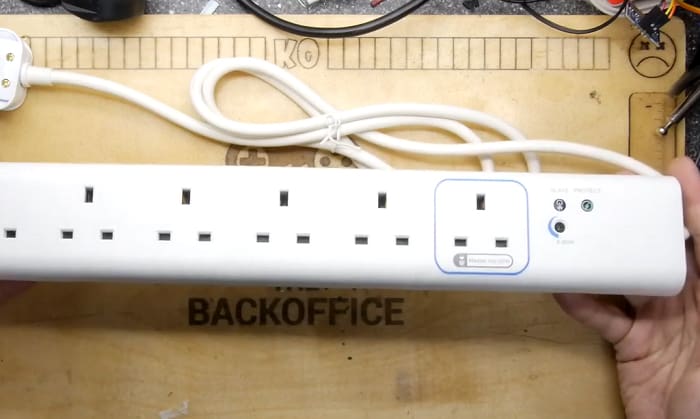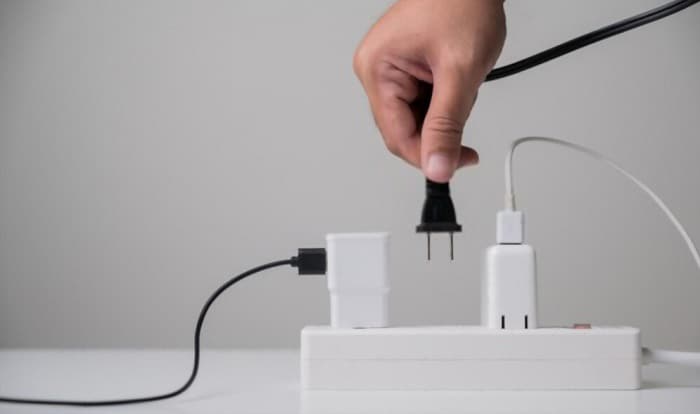If you acknowledge that every appliance or device will inevitably break down over time, then it shouldn’t be hard to answer “Can power strips go bad?”
Yes, they will inevitably fail to serve their purpose of providing multiple outlets for your gadgets. Power strips and extension cords expire after 5 years on average.
However, if the components are still working and well-designed, they’ll last longer and can still be used. How do I know? Good signs to look out for are properly soldered connectors, flexible insulation, and intact sockets that secure plugs well.
Table of Contents
Do Power Strips Last Forever?
Simply put, they don’t. Once a strip hits the four or five-year mark, it’s high time to start considering replacing them.
If you’ve had an old extension cord that you’ve been using for seemingly forever, chances are, it’s just a well-constructed contraption. Or the longevity could be attributed to something as simple as you using them properly (i.e. not often).
In fact, I can safely say that a few older power strips are higher quality than some of the flimsy new ones I’ve recently come across. I can say as much for those whose manufacturers integrated the right-sized MCB into their strips, which have better resistance against electrical faults.
That being said, if you’re close to 100% sure about the product quality, then age shouldn’t be a significant safety factor. Sure, cords may short out inevitably, but no one can tell for sure when that will happen.
And what’s to worry about if you’re not subjecting your cables to much abuse, unlike some folks? However, if you (willingly or grudgingly) count yourself among these users, I highly recommend you regularly replace your power strip.
Learn to Use Your Power Strip Correctly
All the better if you exert the effort to maintain the strip. Keep power strips safe by putting them in a dry environment; doing this goes a long way in extending their life already.
More importantly, learn to use them properly. Here are a few guidelines whose efficacy I can attest to.
- First and foremost, never overload power strips. Refrain from plugging high-draw appliances into them, especially kitchen ones such as coffee pots, refrigerators, oven toasters, and microwaves.
How many watts can a power strip handle? 1800 watts is a common figure, but to be exact, refer to the manufacturer’s info sheet or product description.
- If your power strip is a surge protector, don’t be 100% sure that it’s automatically set for a long life just because it has protection.
You never know when a single surge may happen that will cut its life short, so be mindful of overloading risks when using it, too.
- If a wall outlet is available, then prioritize using that instead of using a power strip as a main power source. Always consider it as secondary to wall plugs if your purpose is long-term use.
Components That Expire
To gain a more satisfactory answer to, “How long do power strips last?” we need to look at which components are prone to expiring over time. Look out for the ones in this list, specifically:
- The plug prongs at the ends will tend to loosen and degrade as time passes. As said above, I use the plug’s overall state to decide whether I’ll replace the strip or not.
- The plastic components (g. the power strip reset button) break down faster, especially if the power strip is in a less-than-ideal, wet environment.
- Any part made of metal (e.g. the prongs) may corrode quickly, all the more so if no corrosion protection like anodization was applied to it. This can be prevented by regularly cleaning the component with an electrical contact clean
- The wires tend to last longer than most, way more than a power strip’s average lifespan, but will eventually become flimsy after at least a decade.
These facts also explain how to tell if a power strip is bad, so it’s well worth remembering them. Once you see any of these signs on a strip’s components, it already warrants replacing.
FAQs
How long can power strips last?
While there’s no definitive number of years for when power strips will stop working, it’s best to consider replacing them after 5 years. That’s already the maximum for most as people don’t mind buying a new one once their old strip enters its third year.
However, there are certainly exceptions to that rule, as some devices remain safely usable beyond those times. On the whole, there’s nothing wrong with guaranteeing your and your gadget’s safety, so it’s just fine to follow the regular replacement recommendation, too.
When should you replace a power strip?
Besides asking do power strips go bad, you should also know when to replace them. If the plugs heat up quickly, the cable starkly changes its color, or the prongs have poor contact, consider them as warning signs of a power strip that’s deteriorating.
Moreover, check the components for the tell-tale signs I shared above.
Can you test your power strip’s quality?
You can’t test a power strip simply because there’s no ready way or tool that you can use to perform such a task. Being UL 1363 listed serves as a reliable sign of quality and safety already.
If it’s a surge protector, the manufacturer has more than likely subjected it to different surge tests prior to its release in the market.
Can old power strips be dangerous?
In discussions about risk, especially ones pertaining to power strip vs surge protector, the latter almost always wins due to the additional protection it provides alone. Once age enters the picture, risks of electrical accidents only become more pronounced for both.
So yes, power strips getting along in years are unquestionably risky because their components may malfunction, especially during a surge, and cause a fire.
Conclusion
As a recap, can power strips go bad? Beyond doubt, they can. But much like most appliances (and people), we can’t stick an expiration date label on every power strip we buy.
There are way too many variables involved, such as quality of make and components, usage and maintenance habit, and unforeseen events that may cause it to go out of commission suddenly.
To be safe, don’t have any second thoughts about following the guideline and replacing power strips every five years. Don’t take the convenience they bring for granted.
Read more: The common reasons why the power strip keeps turning off.

I am Edwin Jones, in charge of designing content for Galvinpower. I aspire to use my experiences in marketing to create reliable and necessary information to help our readers. It has been fun to work with Andrew and apply his incredible knowledge to our content.



